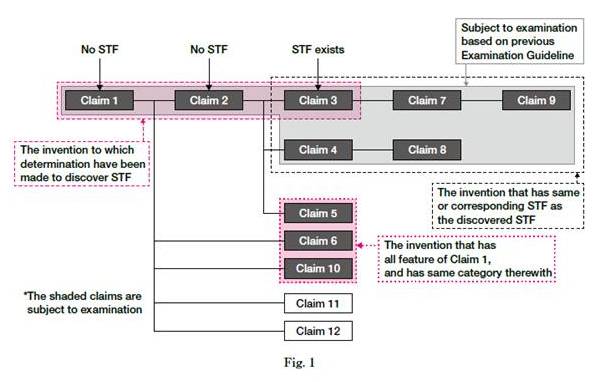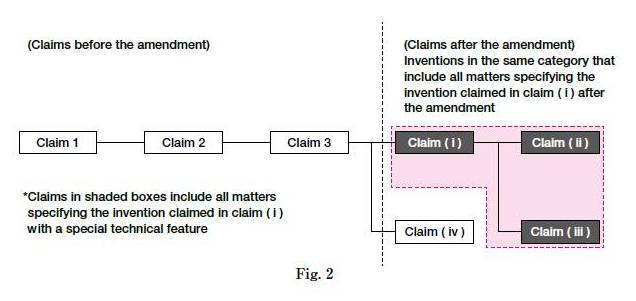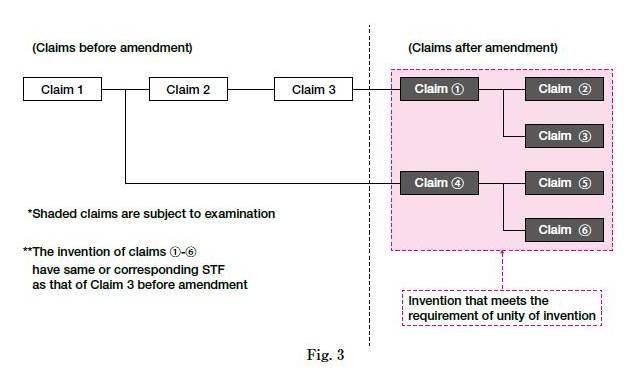New Examination Guideline for Unity of Invention and Restriction of Amendment in Response to the Rejection of Lack of Unity of Invention
Territory:Japan
Practices:Patents
Category:Laws
YUASA AND HARA INTELLECTUAL PROPERTY NEWS (Vol.37, Aug. 2013)
Shogo Nakamura (Mr.)
Patent Attorney of the Patent Division
1. Introduction
In July 2013, Japan Patent Office published new examination guideline regarding the range of substantial examination beyond the range that satisfies the unity of invention requirement. All the patent application currently pending are to be examined in accordance with this new guideline.
This paper first explains the difference in the basic concept of the unity of invention among Japan, USA and EPO.
Further, it explains the summary of the new guideline as to the range of substantial examination beyond the range that satisfies the unity of invention requirement, followed by the explanation about the countermeasure to be taken in response to the issuance of lack of unity rejection.
2. The difference in the basic concept of the unity of invention among Japan, USA and EPO
The followings are our brief comparison about unity of invention in USA, EPO and Japan
2.1 USA
MPEP stipulates as follows:
802.01 Meaning of “Independent” and “Distinct” [R-5]
INDEPENDENT
The term “independent” (i.e., **>unrelated<) means that there is no disclosed relationship between the two or more inventions claimed, that is, they are unconnected in design, operation, and effect. For example, a process and an apparatus incapable of being used in practicing the process are independent inventions.
MPEP is not concerned with “technical contribution” of the claimed invention over prior arts. It is only concerned with connection in design, operation, and effect of the claimed inventions.
2.2 EPO
EPC Rule 44 stipulates as follows:
Unity of invention
(1) Where a group of inventions is claimed in a European patent application, the requirement of unity of invention under Article 82 shall be fulfilled only when there is a technical relationship among those inventions involving one or more of the same or corresponding special technical features. The expression “special technical features” shall mean those features which define a contribution which each of the claimed inventions considered as a whole makes over the prior art.
EPC is concerned with “technical contribution” of the claimed invention over prior arts.
2.3 Japan
Article 25octies of Regulations under the Patent Act stipulates as follows:
(1) The technical relationship defined by Ordinance of the Ministry of Economy, Trade and Industry under Patent Act Article 37 means a technical relationship in which two or more inventions must be linked so as to form a single general inventive concept by having the same or corresponding special technical features among them.
(2) The special technical feature provided in the former paragraph stands for a technical feature defining a contribution made by an invention over the prior art.
(3) The technical relationship provided in the first paragraph shall be examined, irrespective of whether two or more inventions are described in separate claims or in a single claim written in an alternative form.
Japanese Patent Act Article 25octies is concerned with “technical contribution” of the claimed invention over prior arts.
At JPO the range that the Examiner examines is limited as explained below, which includes small addition to the range of unity explained above.
3. A Summary of New Guideline
Under the new Guideline, the Examiner examines the existence of novelty of all the inventions of the claims and also examines the existence of feature(s) shared by invention of all the claims that makes the invention novel [being referred to as “Special Technical Feature (STF)” by JPO].
(a) If the Examiner determines that the invention of all the claims share the feature in common that makes all the invention in the claims novel, he/she further examines the invention of all the claims in terms of inventive step, clarity, enablement etc [hereinafter referred to as “substantial examination”].
(b) If the Examiner determiners some of the inventions in the claims lack novelty or do not share feature(s) in common that make(s) the invention novel, then he/she conducts substantial examination for
(b-1) the invention of the group of claims that satisfy the condition of (a), the top claim of the group having smallest claim numbering in the initially filed claims [corresponding to claims 3, 7 and 9 in Fig. 1 below];
(b-2) the invention of the claims that share the same or corresponding feature(s) that make(s) the invention novel [corresponding to claims 4 and 8 in Fig. 1 below]
[the explanation of what concretely means “corresponding” has not been expressly published] ; or
(b-3) the invention of the claims that share all the feature of the smallest claim numbering in the initially filed claims, which have same category [e.g., apparatus, method] therewith, and the examination to which is possible without incurring substantial and additional prior art search or additional legal determination [corresponding to claims 5, 6 and 10 in Fig. 1 below][the explanation of what concretely means “without incurring substantial and additional prior art search or additional legal determination” has not been expressly published]
4. Freedom of amendment after receiving first Official Action
(4-1) For the case none of the invention of the claims has novelty in the first Official Action
As illustrated in Fig-2, one can file amendment to the claims:
-That has only one independent claim (i) that has all the limitations of the narrowest claim that depend on previous claim 1 as well as all the limitations of the intermediate claims between claim 1 and the narrowest claim, and the limitations of claim 1, the dependency being selected in a manner that smallest claim numbering determined when next dependent claim is chosen, wherein the new independent claim (i) should entail additional feature (i-add) that makes the invention of the claim novel.
[This (i-add) should be drafted in a manner that already existing claim element (each step or each means) is further limited in scope. Please refer to the following section “4-3” for the meaning of “further limiting the scope of each element”]
-That may include dependent claims that depend on claim (i).
If you add claim (iv) that does not have novelty, it is not further examined, and adding such claims will constitute independent reason for rejection.
(4-2) For the case some of the invention of the claims has novelty in the first Official Action
As illustrated in the above drawing, in which previous claim 3 has novelty, we can file amendment to the claims in a manner:
(manner A: corresponding to claims ①,② and ③)
-That has as many independent claims like claim ① above, that has all the limitations of claim 1 through 3, as possible.
-That may include dependent claims that depend on claim ①.
(manner B: corresponding to claims ④,⑤ and ⑥)
-That has as many independent claims like claim ④, which has same or corresponding STF [*d] as that of claim 3 before the amendment
[the explanation of what concretely means “corresponding” has not been expressly published];
-That may include dependent claims that depend on claim ④.
(4-3) Repercussion for not abiding by the above restrictions
Filing the claim amendment that does not meet the above requirement would trigger final rejection to which freedom of amendment is extremely limited.
[By having in the application the amended claims not abiding by the above restriction, even for the claims abiding by the restriction face the following restriction when tries to file further amendment. Only remedy for this is filing divisional application.]
We can only either:
(a) Cancel claims,
(b) Further limit the scope of each element (each step or means) of the claims,
(c) Correct typographical error
(d) Rephrase unclear description.
Further limiting the scope of each element of the claims means something like the following:
-Amending “heating the material with high temperature” to “heating the material with 100-200 degree” is allowed.
-We cannot add new element “cooling the material” as new element, even such element is disclosed in the specification.
-The aim of this restriction is to avoid re-searching by the Examiner.
(4-4) Safe harbor for the claims that do not meet the above requirement
Only way out for us for the claims that do not meet the above requirements to be substantially examined is to file a divisional application covering such claims.
5. Conclusion
As illustrated in Fig. 1, range of substantial examination has been somewhat relaxed from the previous Guideline, although still being not comparable with U.S. and European counterpart.
If we are to give you one advice, it is to file claims that have at least novelty over the potential references, if not inventive step, where the element that makes the claims novel being shared by all the claims.
The concept of the unity of invention, the range of substantial examination and allowable range of claim amendment in response to the issuance of lack of unity rejection are quite complicated.
We are more than happy to provide you with additional explanation thereof.
Authors
Patent Division, Electrical SectionAssociates Patent Attorneys
NAKAMURA, Shogo
[Practices]
Patents
Legal updates on Patents
Telephone
+81(3)3270-6641




